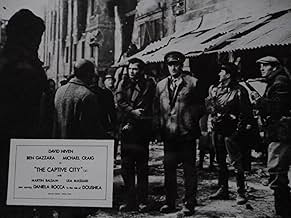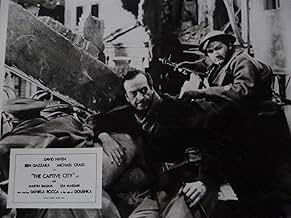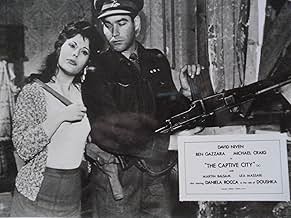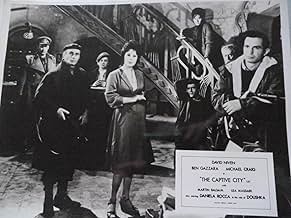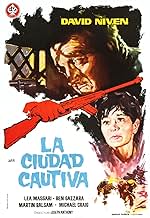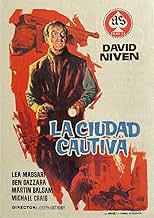An Athens hotel, full of refugees and expatriates is captured by Allied troops in the closing days of the War. British Major Whitfield has to prevent a cache of hidden weapons from falling i... Read allAn Athens hotel, full of refugees and expatriates is captured by Allied troops in the closing days of the War. British Major Whitfield has to prevent a cache of hidden weapons from falling into the hands of renegade troops.An Athens hotel, full of refugees and expatriates is captured by Allied troops in the closing days of the War. British Major Whitfield has to prevent a cache of hidden weapons from falling into the hands of renegade troops.
Featured reviews
The film is a masterful exercise in psychological tension, almost entirely set within a single building in occupied Athens, where a small group of characters faces the relentless threat of partisan forces. The director demonstrates remarkable control over confined spaces: narrow corridors, stairwells, and dimly lit rooms are framed to heighten both claustrophobia and a constant sense of danger. Lighting is employed with precision-muted natural light and shadow interplay not only create visual depth but also mirror the mental strain and paranoia experienced by the characters.
Cinematography is subtle yet highly effective. Long, static takes allow minor gestures, glances, and shifts in posture to convey profound psychological weight. This measured approach to framing and pacing keeps the audience tense without resorting to action-driven spectacle. The camera often lingers in tight spaces, emphasizing the characters' isolation while capturing the oppressive atmosphere of a building under siege.
David Niven delivers a performance of understated gravitas, using calm authority and controlled expression to anchor the ensemble. His moments of internal conflict are conveyed through minimalistic gestures and restrained facial cues, demonstrating his mastery of psychological nuance. Ben Gazzara provides a contrasting intensity, portraying a character constantly on edge, whose volatility and subtle expressions of fear heighten the tension within the group. The interplay between Niven's measured composure and Gazzara's simmering anxiety generates a dynamic energy that carries much of the film's suspense. Supporting actors are consistently strong, creating a believable ensemble of individuals under extraordinary pressure, though occasional minor roles verge on conventional, which slightly diminishes the complexity of the group dynamic.
Editing and pacing are deliberately controlled, emphasizing the slow accumulation of stress over sudden action. Extended takes and carefully timed cuts reinforce the sensation of entrapment and unrelenting pressure. The sound design is particularly effective: distant footsteps, muffled voices, and intermittent gunfire or knocks on doors maintain a constant auditory tension. The sparse musical score underscores critical moments without ever breaking the realism of the siege, allowing silence and ambient noise to dominate, which amplifies the psychological intensity.
From a historical perspective, the film's 1962 production reflects a period in European cinema where World War II was explored through intimate, morally complex experiences rather than grand battle narratives. Its focus on a small group trapped in an urban environment highlights both the human cost of occupation and the ethical dilemmas inherent in survival under extreme conditions. The choice of Athens as a setting contributes architectural authenticity and symbolic weight, representing the broader experience of occupied cities during the war.
Technically, the film excels in spatial composition, lighting, and sound, creating a sense of pervasive unease and continuous threat. Some sequences intentionally disorient the viewer with overlapping spaces or shadowed corridors, mirroring the characters' own uncertainty and fear. While the deliberate pacing may feel slow to those expecting conventional wartime action, it serves to immerse the audience in the psychological reality of siege, making every glance, pause, and whispered conversation fraught with tension.
Overall, the film's success lies in its combination of meticulous cinematography, disciplined acting, immersive sound design, and psychologically informed direction. The performances of David Niven and Ben Gazzara, in particular, anchor the narrative, allowing viewers to experience the claustrophobia, paranoia, and moral tension of life under siege in a way that remains compelling and affecting throughout the film.
Cinematography is subtle yet highly effective. Long, static takes allow minor gestures, glances, and shifts in posture to convey profound psychological weight. This measured approach to framing and pacing keeps the audience tense without resorting to action-driven spectacle. The camera often lingers in tight spaces, emphasizing the characters' isolation while capturing the oppressive atmosphere of a building under siege.
David Niven delivers a performance of understated gravitas, using calm authority and controlled expression to anchor the ensemble. His moments of internal conflict are conveyed through minimalistic gestures and restrained facial cues, demonstrating his mastery of psychological nuance. Ben Gazzara provides a contrasting intensity, portraying a character constantly on edge, whose volatility and subtle expressions of fear heighten the tension within the group. The interplay between Niven's measured composure and Gazzara's simmering anxiety generates a dynamic energy that carries much of the film's suspense. Supporting actors are consistently strong, creating a believable ensemble of individuals under extraordinary pressure, though occasional minor roles verge on conventional, which slightly diminishes the complexity of the group dynamic.
Editing and pacing are deliberately controlled, emphasizing the slow accumulation of stress over sudden action. Extended takes and carefully timed cuts reinforce the sensation of entrapment and unrelenting pressure. The sound design is particularly effective: distant footsteps, muffled voices, and intermittent gunfire or knocks on doors maintain a constant auditory tension. The sparse musical score underscores critical moments without ever breaking the realism of the siege, allowing silence and ambient noise to dominate, which amplifies the psychological intensity.
From a historical perspective, the film's 1962 production reflects a period in European cinema where World War II was explored through intimate, morally complex experiences rather than grand battle narratives. Its focus on a small group trapped in an urban environment highlights both the human cost of occupation and the ethical dilemmas inherent in survival under extreme conditions. The choice of Athens as a setting contributes architectural authenticity and symbolic weight, representing the broader experience of occupied cities during the war.
Technically, the film excels in spatial composition, lighting, and sound, creating a sense of pervasive unease and continuous threat. Some sequences intentionally disorient the viewer with overlapping spaces or shadowed corridors, mirroring the characters' own uncertainty and fear. While the deliberate pacing may feel slow to those expecting conventional wartime action, it serves to immerse the audience in the psychological reality of siege, making every glance, pause, and whispered conversation fraught with tension.
Overall, the film's success lies in its combination of meticulous cinematography, disciplined acting, immersive sound design, and psychologically informed direction. The performances of David Niven and Ben Gazzara, in particular, anchor the narrative, allowing viewers to experience the claustrophobia, paranoia, and moral tension of life under siege in a way that remains compelling and affecting throughout the film.
Did you know
- TriviaNot released in the US until 1965.
- ConnectionsReferenced in Michael Craig (2022)
Details
- Runtime
- 1h 45m(105 min)
- Color
- Sound mix
Contribute to this page
Suggest an edit or add missing content

